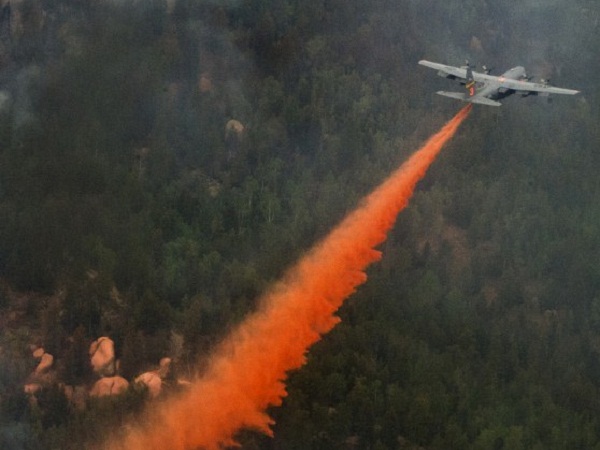
This photo obtained July 3, 2012 courtesy of the US Air Force shows The 153rd Airlift Wing from Cheyenne Wyoming as it uses a modular air fire fighting system equipped C-130 Hercules aircraft in support of the Waldo Canyon wild fire in Colorado Springs, Colorado on June 27, 2012. Four MAFFS-equipped aircraft from the 302nd and 153rd Airlift Wings flew in support of the US Forest Service as they fought fires in Colorado. MAFFS is a self-contained aerial fire fighting system that can discharge 3,000 gallons of water or fire retardant in less than five seconds, covering an area one-quarter of a mile long by 100 feet wide. Responsible for the extreme early-summer weather has been a high pressure area parked over the southeastern United States -- the same slow-moving weather system blamed for a fatal wildfire in Colorado earlier in the week. Firefighters supported by water bombers managed over the weekend to contain much of the Waldo Canyon inferno that killed three people, destroyed nearly 350 residences and left many hundreds homeless. AFP PHOTO/US AIR FORCE/STEPHANY D. RICHARDS
WASHINGTON — The crash of a fire-fighting C-130 aircraft in South Dakota over the weekend killed four crew members and injured two others, the US military said Tuesday.
The Air National Guard released the casualty toll and announced its fleet of specially-equipped planes were cleared again for flights, after having been grounded for a day to review safety measures following Sunday’s crash.
The C-130 went down while battling a woodland fire in the southwestern state of South Dakota.
The fire-fighting cargo planes have been in heavy use this month amid a spate of wildfires, including the worst in Colorado’s history.
Blazes in Colorado have burned through more than 100,000 acres (40,000 hectares) and authorities estimate they won’t be fully contained until July 12 at the earliest.